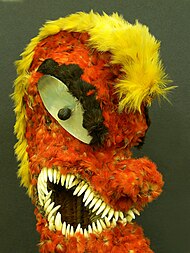Kū

In Hawaiian mythology Kū or Kūkaʻilimoku is one of the four great gods. The other three are Kanaloa, Kāne, and Lono. Feathered god images or 'aumakua hulu manu are considered to represent Kū. Kū is worshipped under many names, including Kū-ka-ili-moku (also written Kūkaʻilimoku), the "Seizer of Land". Kūkaʻilimoku rituals included human sacrifice, which was not part of the worship of other gods.
Mythology
He is known as the god of war and the husband of the goddess Hina.[1] Some[who?] have taken this to suggest a complementary dualism, as the word kū in the Hawaiian language means " to stand " while one meaning of hina is " to fall ".[2] This analysis is not supported by evidence from other Polynesian languages which distinguish the original "ng" and "n". Hina's counterpart in New Zealand for example, is Hina, associated with the moon, rather than Hinga, "fallen down". Thus, the Hawaiian name Hina is probably rather connected to the other meaning of hina, denoting a silvery-grey color[2] (like the full moon); indeed the moon is named Mahina in the Hawaiian language. Kū, Kāne, and Lono caused light to shine in upon the world. They are uncreated gods who have existed from eternity.[3]
Guardian statues of Kamehameha I
Kūkaʻilimoku was the guardian of Kamehameha I who erected monuments to the deity at the Holualoa Bay royal center and his residence at Kamakahonu. Three enormous statues of the god Kū were reunited for the first time in almost 200 years at the Bishop Museum in Honolulu in 2010.[4] They were dedicated by Kamehameha at one of his temples on the archipelago in the late eighteenth or early nineteenth centuries. These very rare statues (no others are known extant) were later acquired by the Bishop Museum, the Peabody Essex Museum in Salem, Massachusetts and the British Museum in London.[5][6] One feathered god image in the Bishop Museum, Honolulu is thought to be Kamehameha I's own image of his god. However it is still unclear whether all feathered god images represent Kū.[7]
See also
- Tūmatauenga, Māori war deity.
- The Kailua-Kona lighthouse was built on land known as Kūkaʻilimoku Point.
Notes
- ^ Beckwith (1970): p.12
- ^ a b Pukui et al. (1992): p.25
- ^ Tregear (1891): p.540
- ^ Honolulu Advertiser Article
- ^ Peabody Essex Museum Oceanic Collection
- ^ British Museum Highlights
- ^ "`aumakua hulu manu Kuka`ilimoku (feathered god image)". Collections Online. Museum of New Zealand Te Papa Tongarewa. Retrieved 16 November 2010.
References
- Beckwith, M. (1970): Hawaiian Mythology. University of Hawaii Press, Honolulu.
- Tregear, Edward (1891): Maori-Polynesian Comparative Dictionary. Lyon and Blair, Wellington..
- Pukui, Mary Kawena; Elbert, Samuel Hoyt; Mookini, Esther T. & Nishizawa, Yu Mapuana (1992): New Pocket Hawaiian Dictionary with a Concise Grammars and Given Names in Hawaiian. University of Hawaii PRess, Honolulu. ISBN 0-8248-1392-8
